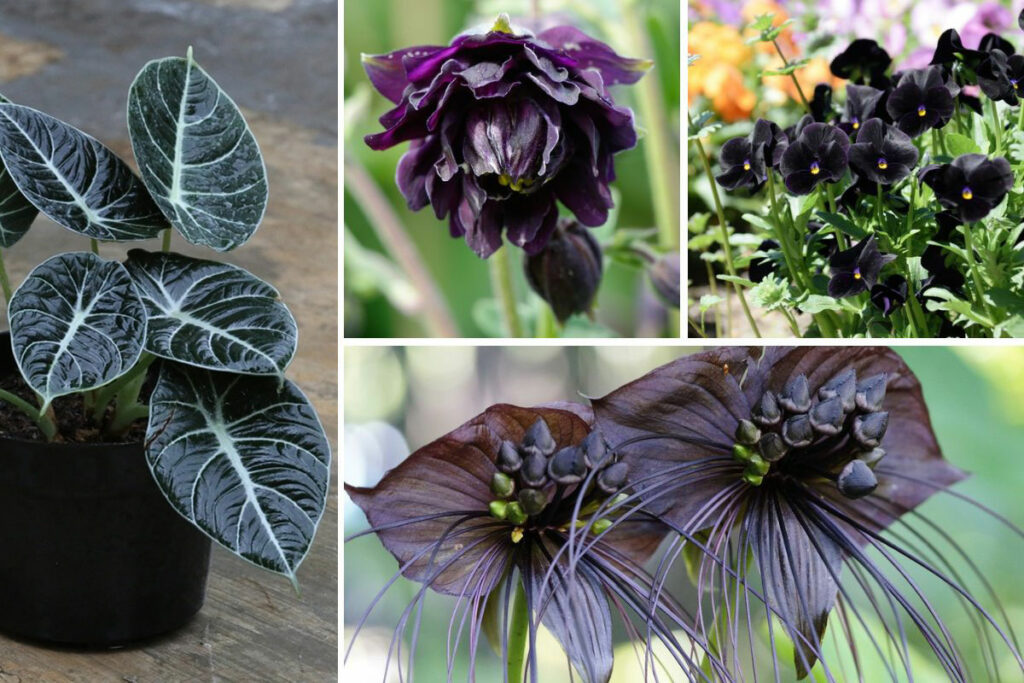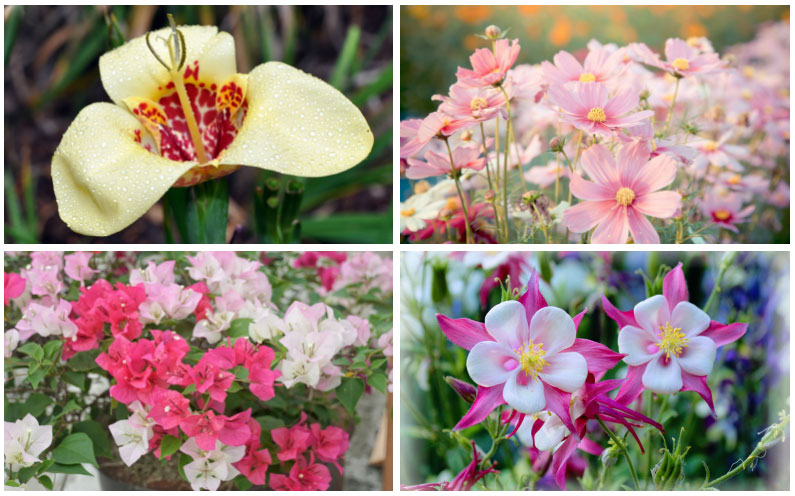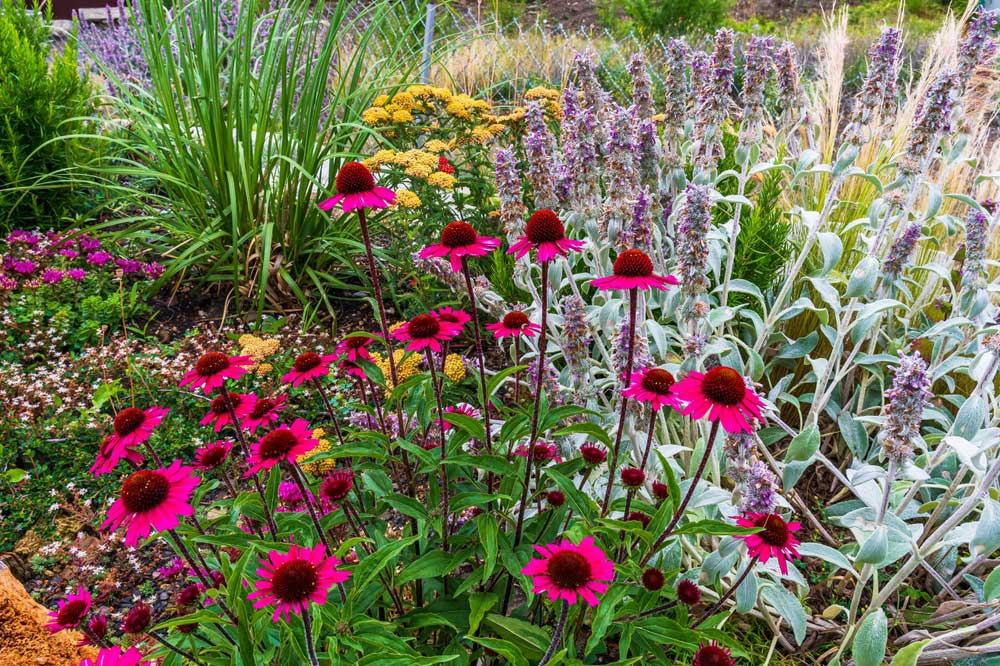Typically, gardens house vibrant and colorful flowers. Yet, growing dark flowers and plants in your garden can add an interesting, sophisticated contrast.

Moreover, black flowers are a sure way for your garden to stand out. Luckily, there are many black, long-lived perennials that you can permanently grow with little effort.
Still not convinced? Well, there’s no doubt that you’ll want to plant some unique dark flowers once you read our list of 15 black perennials. Let’s dive in!
1. Black Velvet

Alocasia black velvet is one of the most astonishing perennials. It’s known for its dark, velvety leaves that make a mesmerizing addition to any home.
The great thing is that you can easily grow black velvet indoors even if you’re new to gardening. That’s because it’s fairly low-maintenance. You don’t even need to care for its flowers. Instead, you should remove the blooms regularly to allow the leaves to thrive.
This plant loves humidity. However, it’s prone to root rot, so you should carefully balance the water level. Only water black velvet when the soil is dry about one inch down.
2. Hollyhock

You’re probably used to seeing vibrant, pink hollyhocks. Yet, the black variety of hollyhock is fascinating. Its flowers are small and modest, so they won’t completely overpower the room. Alternatively, they add a touch of sophistication to your home.
Though, it may take a little while for your hollyhocks to bloom. If you’re growing them from seed, it’ll take two years before you’re greeted with beautiful, black flowers.
To grow hollyhocks, you need to place them in fertilized, well-drained soil, in full sun. Furthermore, if you want your flowers to bloom earlier, you might try planting the seeds during the fall or treating them with gibberellic acid.
3. Viola Bowles Black

Viola Bowles black, also known as winter pansies, are incredibly unique. Not only is their color jet black, but their contrasting bright yellow eyes make for a gorgeous sight.
This plant grows extremely fast, and blooms during the spring or early summer. Additionally, the flowers are edible. So, not only will you have a gorgeous black ground cover, but you can also add them to your salad.
It’s easy to take care of violas. They’re quite tolerant of heat and moisture and thrive in different soil pH levels. They also require frequent watering and well-drained soil.
4. Bearded Iris

The black-bearded iris looks straight out of a goth movie. This tall plant blooms into gorgeous ruffled dark violet flowers.
You must know that all parts of this plant are poisonous to cats, dogs, and humans. So, if you have young children or pets, it might not be the best choice.
To keep your iris green and healthy, plant it in full sun. Also, you should place your iris in well-drained, humus-rich soil.
5. Black Snakeroot

You might know black snakeroot by its common name, black cohosh. Its leaves are gorgeously distinct. The foliage ranges from burgundy to dark chocolate-brown and has spiky edges.
During July or late June, black snakeroot will greet you with contrasting white blooms. These flowers might reach up to 7 feet in height.
Black snakeroot is easy to care for, as long as you place it away from direct sun. It tolerates colder weather and high moisture.
6. Blackberry Petunia

Blackberry petunias are sophisticated bedding plants. They’re quite hardy, which means you can grow them indoors or outdoors, even if you live in the city!
Petunias can be annual or perennial. This means you can have fast-growing plants that bloom in only one year or longer living petunias.
These blossoms need a bit of maintenance and care. Make sure to place your petunias in full sunlight and water them often. To encourage healthier blooms, you should cut the wilted flower heads.
7. Black Dahlia

Nothing compares to the beauty of black dahlia. The dark maroon petals darken in the middle to a near-black color.
There are many varieties of black dahlia, some are small, and others might be a foot wide! Some popular varieties include Arabian night and Black Wizard.
You should be patient when growing black dahlias. The plant needs full sun, plenty of water, and fertilizer at least once a month. Yet, all your effort will be worth it once you see the stunning blossoms in the autumn.
8. Black Tulip

There’s a reason the black tulip is deemed the queen of the night. This stunning tulip variety has dramatic velvety, deep-purple petals.
There’s no doubt that tulips look amazing in any garden. Their relatively tall height allows them to stand out among other flowers in your garden. They’re also quite hardy and low-maintenance!
Black tulips need full sun and a small amount of water. So, you should plant your tulips in well-drained soil, and place them outdoors, or in direct sunlight.
9. Onyx Odyssey

Having an onyx odyssey in your flower garden is definitely a conversation starter. The blossoms of this plant are quite large, reaching about 3 inches in diameter.
Though what makes onyx odyssey so special is its rich black color that doesn’t fade over time. You can enjoy these blooms for weeks from late winter to early spring.
Additionally, the onyx odyssey is low-maintenance and hardy. Plant it outdoors under a large tree for shade. Make sure the soil is nutrient-rich, and only water every couple of days. Then, you’ll have a long-lasting, self-seeding plant!
10. Black Barlow Columbine

Black Barlow Columbine features exquisite, long, deep-violet petals. These divine flowers are pendants and sit on quite tall stems, reaching about 2–3 feet. So, they’ll make a gorgeous adornment to the shady areas in your garden.
This flower blooms twice a year, once during the late spring, then again at summer’s end! Once it blooms, butterflies will fill your garden!
You don’t need a lot of experience to grow black Barlow Columbine. You should plant the seeds in partial shade, and water only when the soil is dry.
11. Persian Lily

Lilies are some of the best flowers to enhance your gardens. Persian lilies have dramatic deep-plum florets which makes them even more sophisticated.
Persian lilies bloom in mid-spring. The floret groups are arranged on a tall, central stalk, adding gorgeous vertical stature to your garden.
Luckily, Persian lilies are quite easy to grow. They need moist, well-drained soil, and full or partial light.
12. Black Mondo Grass

Black mondo grass is a clumping, easy-to-care-for, groundcover, that also provides a gorgeous sight.
If you want an interesting carpet for your garden, black mondo grass is the way to go. You can plant only a small area, and in a couple of years, the plant’s horizontal rhizomes will grow into newer plants.
Caring for black Mondo grass couldn’t be easier. That’s because it’s drought-resistant, pest-resistant, and even deer-resistant. Just water your black mondo grass regularly and place it in full sun to get the darkest black leaves.
13. Bat Flower

Bat flowers look otherworldly due to their wing-like bracts, and long, dark filaments that look like bat whiskers, hence the name!
These flowers can bloom up to eight times in one season! They usually blossom around early spring to late autumn. You’ll need to give your bat flowers some love and attention.
They need well-fertilized soil and shade. You should also repot the plant annually to trim the roots. However, you shouldn’t deadhead them. Instead, allow them to decline naturally.
14. Black Star Calla Lily

Calla lilies are extremely sophisticated, so imagine how unique-looking dark star calla lilies are! The funnel-shaped flowers are great for displaying and even make for gorgeous, goth wedding bouquets.
You can enjoy calla lily blooms during early summer. The flower color varies from red to dark maroon, which appears almost black.
Black star calla lilies are extremely easy to grow. In fact, they can propagate on their own and are then hard to eradicate. They can either grow in sun or shade, yet the black petals are more prominent when grown in the sun.
15. Western Coneflower

Western coneflowers are incredibly interesting. That’s because the head of the flower is discoid and chocolate-colored.
These flowers lie on a tall, rigid stem that can grow up to 6 feet tall. They bloom from June to August, but you can make the bloom last even longer by deadheading the wilted flowers.
You can easily grow western coneflowers in any type of soil and full sun. However, it’s important to protect these long plants from slugs!













